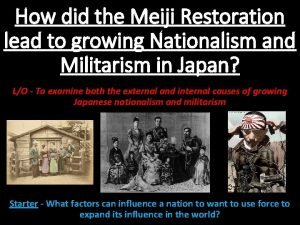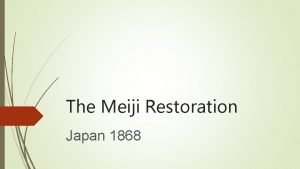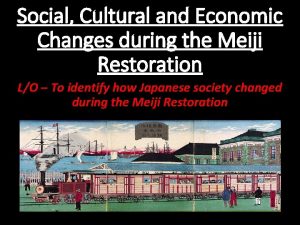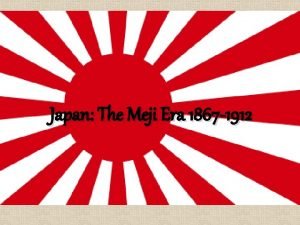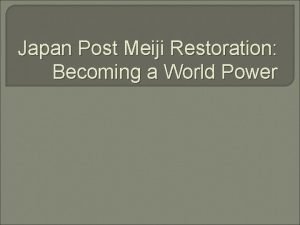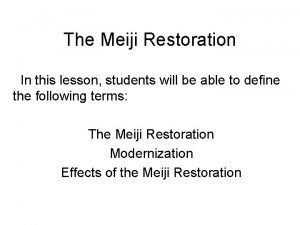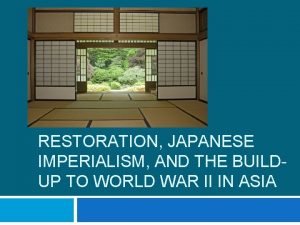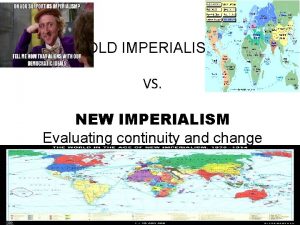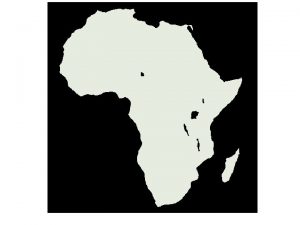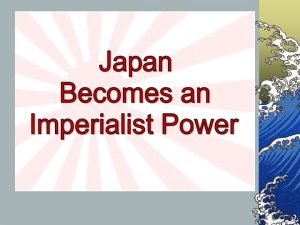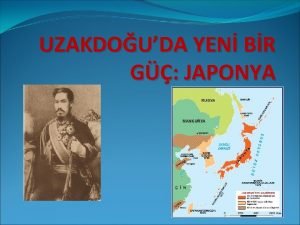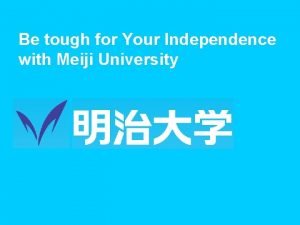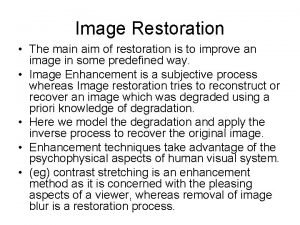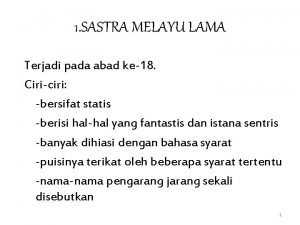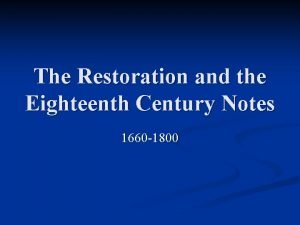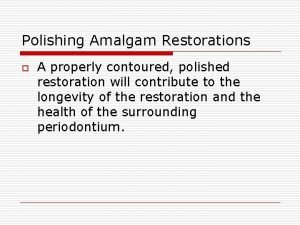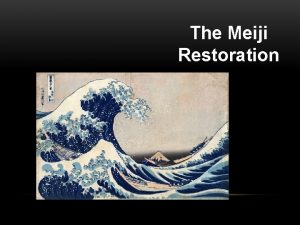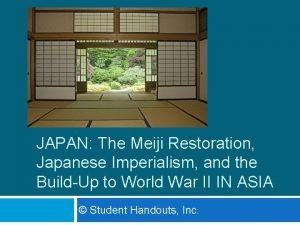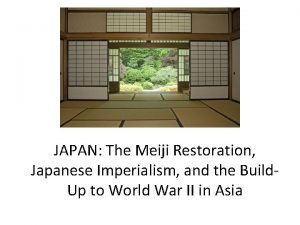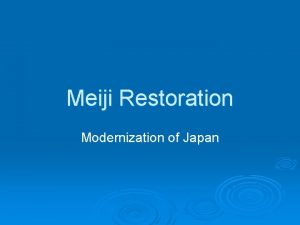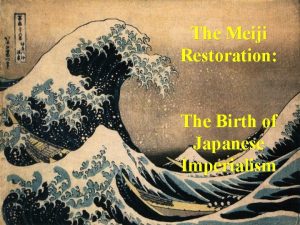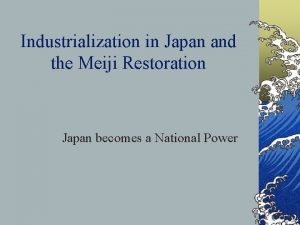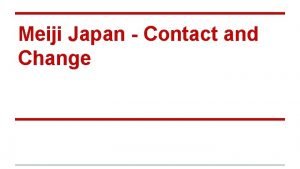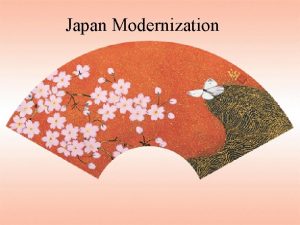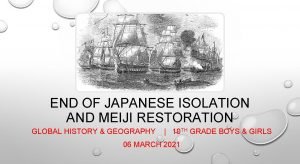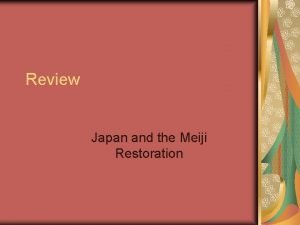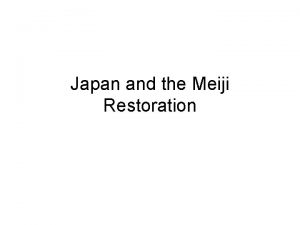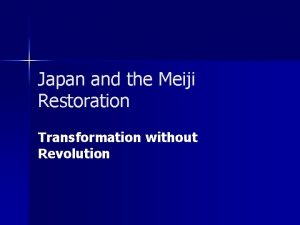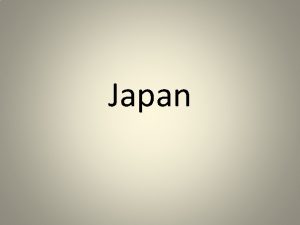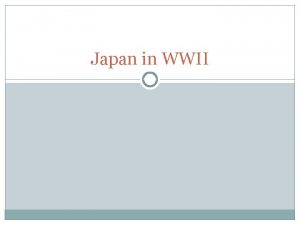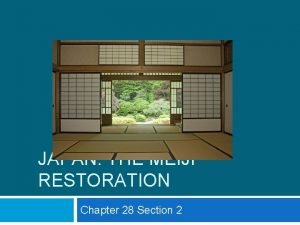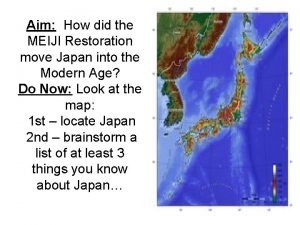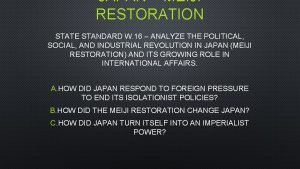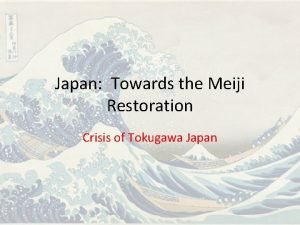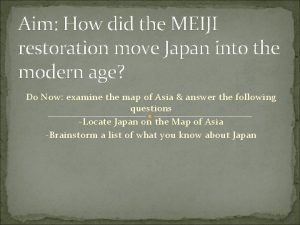JAPAN THE MEIJI RESTORATION JAPANESE IMPERIALISM AND THE






![To Clarify A shogun (将軍 shōgun, [ɕoːɡɯɴ] was the military dictator of Japan during To Clarify A shogun (将軍 shōgun, [ɕoːɡɯɴ] was the military dictator of Japan during](https://slidetodoc.com/presentation_image/031f10cfe1ea51fff3238160704346c3/image-7.jpg)


















- Slides: 25

JAPAN: THE MEIJI RESTORATION, JAPANESE IMPERIALISM, AND THE BUILDUP TO WORLD WAR II IN ASIA

Key Questions How significant was the impact of nationalism and militarism on Japan’s foreign policy ? What impact did Japan’s domestic issues have on foreign policy ? How significant was China’s political instability?

• • 1871 – New Imperial Army created, 10, 000 Samurai 1873 – Mass Conscription Introduced, men 20+ for 3 years 1876 – Treaty of Kanghwa – Unfair treaty imposed on Korea 1882 – Imperial Rescript to Soldiers & Sailors, Indoctrination 1894 -5 – Sino-Japanese War – Japan wins, gains Taiwan 1890 s – Ending of the Unfair Treaties on Japan 1902 – Anglo-Japanese Alliance 1904 -5 – Russo-Japanese War – Japan wins!

Background Real power in Japan before 1867 rested with the largest of Japan’s feudal landowning clans. Before 1600, various clans had come to dominate, only to be replaced by another clan. Tokugawa Clan replaced them all and became the strongest feudal, samurai clan. The head of the clan acted as a shogun, the commanding general of Japan’s armies. Important : The Tokugawa clan used their domination to create a NATIONAL UNITY Main belief was Japanese Superiority Read “ Tokugawa period “ and underline the main features of the period

Tokugawa Yoshinobu was the last shogun ( Keiki) His attempts to modernize and strengthen Japan’s government and his failure to keep foreign states from increasing their contacts with Japan led to the rise of opposition from amongst Satsuma, Choshu, and Tosa samurai clans. They feared that he will transfer emperor’s power to himself along with the power and the government. They raised forces to overthrow him under the slogan ( sonno joi ( revere the emperor, expel the barbarian) Although Tokugawa Yoshinobu resigned and returned all power to the emperor, a brief internal( civil war )- the Boshin War broke out in 1867 as the clans warred between themselves ( Tosa samurai vs Satsuma and Choshu )

The Tokugawa Shogunate Tokugawa family( clan) ruled Japan from 1603 until 1868 – also known as the Edo period 1635 – foreign trade limited to China, Korea, and Netherlands at Nagasaki a few times per year Emperor (Mikado) ruled in name only ( nominative ) Actual power held by the shogun( military dictators )
![To Clarify A shogun 将軍 shōgun ɕoːɡɯɴ was the military dictator of Japan during To Clarify A shogun (将軍 shōgun, [ɕoːɡɯɴ] was the military dictator of Japan during](https://slidetodoc.com/presentation_image/031f10cfe1ea51fff3238160704346c3/image-7.jpg)
To Clarify A shogun (将軍 shōgun, [ɕoːɡɯɴ] was the military dictator of Japan during the period from 1185 to 1868 (with exceptions). The shoguns were the de facto rulers of the country, although nominally they were appointed by the Emperor as a ceremonial formality. A hereditary commander-in-chief in feudal Japan. Because of the military power concentrated in his hands and the consequent weakness of the nominal head of state (the mikado or emperor), the shogun was generally the real ruler of the country until feudalism was abolished in 1867.

Japanese Feudalism Samurai – lived by Bushido, the “way of the warrior” (chivalric code) Emperor de facto Shogun Eight virtues of Samurai (http: //www. artofmanliness. com/2008/09/14/t Daimyo( vassal of he-bushido-code-the-eight-virtues-of-thesamurai/) shogun) Samurai Ronin – those samurai without masters Ninja – a warrior trained to use unorthodox fighting methods (assassination, espionage, martial arts) Peasants, Artisans, Farmers, Merchants, etc.

YOU MUST KNOW ALL THE DEFINITIONS : Write out the definitions at home ultranationalist state- Meiji Restoration- Meiji Constitution- Meiji Emperor- feudalism- Privy Council- samurai- Diet- suffrage- House of Peers/House of Representatives- compulsory education- militarists- radical nationalism/fascism- shogun- Korean tributary state- coup d’etat- First Sino Japanese War- Japan Korea Treaty- Treaty of Shimonoseki- Tripartite Intervention- Liaodong Peninsula- Gashin Shotan- Anglo Japanese Alliance- Russo-Japanese War- Boxer Rebellion- Battle of Tsushima Straits- Treaty of Portsmouth- Great Powers- First World War- Shantung Peninsula- The Twenty One Demands- Paris Peace Conference- League of Nations- mandates- annexed- conscription- Shidehara Diplomacy- Washington Naval Conference- London Naval Conference- Five Power Treaty- Four Power Treaty- Nine Power Treaty- Great Depression- trade barriers- zaibatsu- industrialisation- military production- strikes- communism- Showa Restoration- Showa Emperor- military factions- socialists- Sakurakai- Kodoha- Tosieha- warlord era- Manchuria- Kwantung Army- Kuomintang- CCP-

Encore Before 1867, Japan was a strictly segregated feudal society , with a structure very similar to that which predominated in most European countries during the Middle Ages. In Japan, feudalism lasted longer due to their ISOLATIONISM.

Japanese Culture and Economy Religion Mixture of native Shintoism (living spirits in all things) and Chinese Confucianism (based on the teachings of Confucius) Economy Growing internal trade during the Edo period Merchants began to surpass the samurai in wealth Rigid social stratification But these limits were being tested by the end of the Tokugawa shogunate

End of Japanese Isolation U. S. Commodore Matthew Perry (1794 -1858) 1853 – gunboat diplomacy( this was something much practiced by Britain in Asia- and especially in relation to China. 2 Opium wars were fought against China in order to force the Chinese government to accept Britain’s right to sell opium in China. It was these western acts that forced Japanese nationalistic policy of seclusion and xenophobia. 1854 – trade treaty with the United States Great Britain, Holland (Netherlands), and Russia soon gained similar trading rights Townsend Harris (1804 -1878) United States Consul General to Japan 1858 – commercial treaty between U. S. and Japan European powers soon gained similar rights in Japan Read the article and answer the questions

Japanese Reaction Pros Cons “Dutch Learning” (Western knowledge) became very popular among many doctors, scholars, and scientists Western knowledge went against many traditional Japanese beliefs Japanese entrepreneurs, merchants, and budding industrialists stood to profit from increased trade Resentment Traditional holders of prestige and power (daimyos and samurai) did not tend to profit from increased trade • Extraterritorial rights of Americans and Europeans • Anti-foreign uprisings (1863 -1864) • Japanese ports in turn bombarded by foreign ships Solution • “If you can’t beat ‘em, join ‘em” • Japanese could benefit from knowledge of what happened to China • Japanese felt that they would be in a better position to renegotiate the trade treaties, and be less likely to be imposed upon, if they adopted Western ways (democracy, imperialism, industrialization, militarization, and modernization) – westernization

Meiji Restoration Shogun forced to relinquish power Power officially in hands of Emperor Mutsuhito His reign was called the “Meiji” Japan westernized Quickly went to work crafting a constitution

Brief Overview of Meiji In 1868 the Meiji Revolution (named after the Meiji emperor): 1. restored belief in the divinity of the Emperors; 2. brought a group of far-sighted samurai statesmen to power; 3. revived the ancient local Shinto* religion; 4. created a modem centralized state; 5. restored the power of the Samurai warrior caste; 6. began the transformation of Japan into a modern industrialised state; 7. began the development of an army modelled on the Prussian Army and a navy on the British Navy.

Governmental Reforms Diet – Japan’s bicameral legislature( define the chambers of Diet ) A. an elected House of Representatives and appointed House of Peers) First convened – 1889 Meiji (Imperial) Constitution Adopted – 1890 Followed until the end of World War II

Meiji Structure of the Government

Economic Reforms Abolition of feudalism Currency (yen) adopted, 1872 Encouragement of foreign trade Expansion and encouragement of industrialization Growth of factories First large factories manufactured textiles First textile factory workers were girls and women Land reform Zaibatsu (large conglomerates) built and

Military Reforms Before the Meiji era: Armies were run by local daimyo and thus not subservient to a central government Meiji era: Modern army and navy established which were loyal to the Japanese government Used Prussia (Germany) as primary model Firm belief that if Japan was to be taken seriously by Western powers, and was to avoid China’s fate, Japan would have to compete militarily Conscription (1873) – all men had to serve for three years after turning twenty-one

Social Reforms Universal compulsory elementary education Universities established Westernization of many laws Tokyo University

Social Changes Adoption of Western architecture, fashions, music, and literary styles (magazines and novels) Diversity of intellectual and political thought Growing independence and empowerment of women Movement of peasants from countryside to

Imperialization of Japan Why? Lack of fertile land for agriculture Markets for finished products Need for the raw materials of industry Population growth Response to Western imperialism

Meiji Japan at War First Sino-Japanese War (1894 -1895) Gained: Russo-Japanese War (1904 -1905) Destruction of Russian fleet Finally respected as a world power Treaty of Portsmouth, 1905 Formosa (Taiwan) Liaotung Peninsula (Manchuria) – soon forced to relinquish it Sphere of influence in Korea U. S. President Theodore Roosevelt won Noble Peace Prize Japan was granted the southern part of Sakhalin Island a large sphere of influence in Manchuria Annexation of Korea (1910) World War I Joined Allies Received Germany’s mandates over Asian islands and its leases in the Shantung Peninsula

American and European Opposition Washington Conference (1922) Size limits on navies 5: 5: 3 ratio for Great Britain, United States, and Japanese resented these limitations Nine Power Treaty Four Power Pact China’s independence and territory guaranteed Open Door Policy reaffirmed Imperial Flag of the Japanese Navy France, Great Britain, Japan, United States One another’s colonial possessions would be respected U. S. Japanese Exclusion Act (1924)

Review Questions How did the government of Japan change during the Meiji restoration? Describe Japan’s rationale for its westernization. Describe Japan’s imperialism and militarization. Explain how Japan took control of Manchuria. Imagine that you are a Japanese person watching events unfold in the 1850 s and 1860 s. How might you react? Do you see alternatives to the opening of your country to foreign trade? Do you agree that in order to compete with the Western powers, your nation must begin to behave like the Western
 Japan before meiji restoration
Japan before meiji restoration Meiji restoration
Meiji restoration 5 element of national identity
5 element of national identity Emperor shogun daimyo samurai peasants
Emperor shogun daimyo samurai peasants Meiji restoration
Meiji restoration Meiji restoration definition
Meiji restoration definition Define meiji restoration
Define meiji restoration Old imperialism vs new imperialism chart
Old imperialism vs new imperialism chart Old imperialism vs new imperialism chart
Old imperialism vs new imperialism chart Treaty of kanagawa
Treaty of kanagawa Meiji restorasyonunda yapılan yenilikler
Meiji restorasyonunda yapılan yenilikler Latar belakang restorasi meiji
Latar belakang restorasi meiji Meiji university ikuta campus
Meiji university ikuta campus Peranan koa kunrenjo
Peranan koa kunrenjo Restoration drama and prose
Restoration drama and prose Cameraman.tif
Cameraman.tif Chapter 56 conservation biology and restoration ecology
Chapter 56 conservation biology and restoration ecology Phosphorus cycle pearson education
Phosphorus cycle pearson education John milton drama
John milton drama Image sharpening and restoration
Image sharpening and restoration The restoration and 18th century literature
The restoration and 18th century literature Restoration and enlightenment period
Restoration and enlightenment period Repair and restoration theory of sleep
Repair and restoration theory of sleep The restoration and the 18th century notes
The restoration and the 18th century notes Polishing of amalgam restoration
Polishing of amalgam restoration Chapter 55 ecosystems and restoration ecology
Chapter 55 ecosystems and restoration ecology
